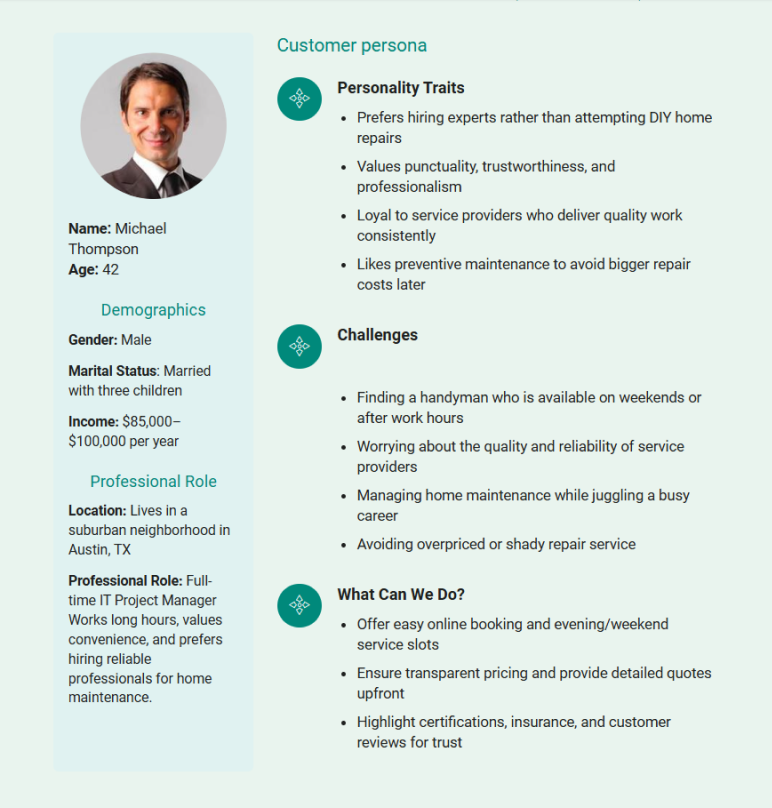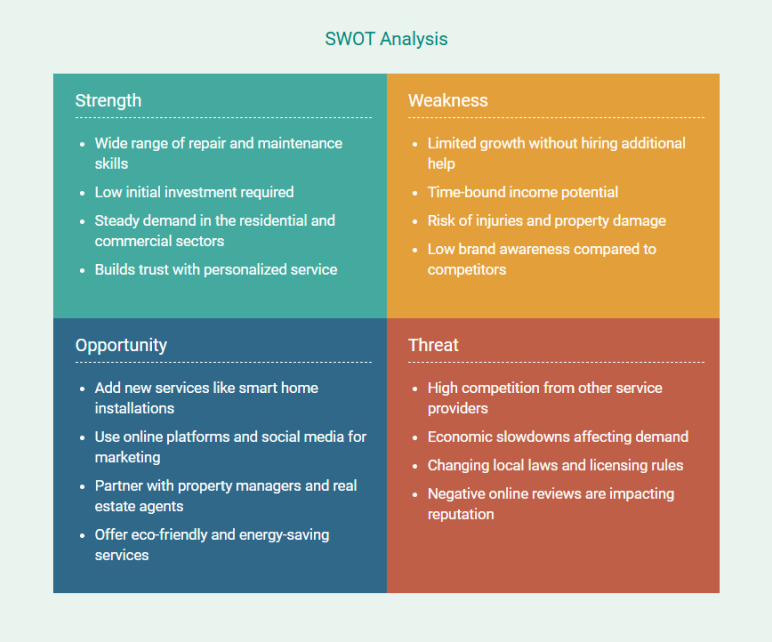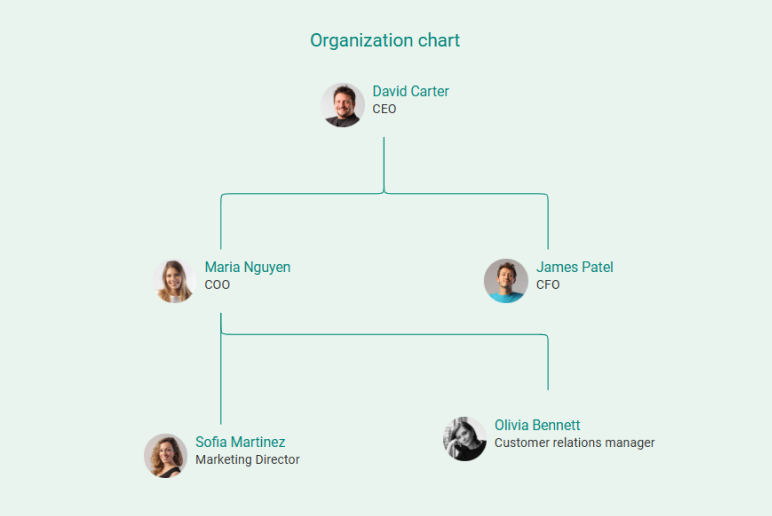So, you’ve got the tools, the talent, and a few loyal customers who love your work—now you’re ready to take your handyman service to the next level.
But before you start booking more jobs or hiring an extra set of hands, there’s one essential step you shouldn’t skip: writing a business plan
A well-crafted handyman business plan is your roadmap, outlining goals, services, target market, marketing strategies, and financial projections.
Don’t know where to start? No worries!
Use this handyman service business plan template to draft a detailed, actionable plan that works best for you.
How to draft an effective handyman business plan?
Writing a business plan may sound daunting, but we’ll break it down into simple steps.
A typical handyman business plan includes several key sections. We’ll go through each one in the order they usually appear in your finished plan.
Follow this step-by-step guide to create a thorough plan that covers all the bases:
1. Executive Summary
The executive summary is the first section of your business plan, but it’s often best to write it last.
Why? Because it’s essentially a one-page snapshot of your entire plan, it highlights the most important points from each section of the plan.
Once you’ve worked out the details in the other sections, you’ll know exactly what key information to summarize here.
In the executive summary, include high-level details about your handyman business:
- Business concept: Start with a clear and brief statement of what your handyman business does.
- Target market: Define who your services are for—homeowners, property managers, or businesses.
- Services you offer: List your core handyman services, such as plumbing, carpentry, or painting.
- What makes you unique: Highlight your edge—certifications, emergency services, or stellar reviews.
- Goals and growth plans: State your main goals and how you plan to expand or improve your business.
- Financial highlights: Include key figures or projections that show financial health or funding needs.
Keep the executive summary clear and compelling. It should grab the reader’s attention and make them want to learn more about your handyman business. Remember to keep it concise, ideally, one page.
Even though it appears first, double-check that it reflects the key points from all the other sections of the plan accurately.
A strong executive summary can make a great first impression, especially if you’re using your plan to seek funding.
2. Business Overview
In the business overview, you’ll provide essential information about your handyman business itself – essentially the “who, what, where, and how” of your company. This section typically includes:
- Start with your business name and location. Mention the legal structure of your business – are you a sole proprietorship, LLC, partnership, or corporation?
- A mission statement is a brief statement of your business’s purpose and values. It explains why you do what you do. For a handyman service, keep it short and genuine – what core mission drives your work?
- If your business is already operational, give a brief history. When did you start, and what progress have you made so far?
- Provide an overview of the types of services you offer as a handyman.
- Identify in general terms who your ideal customers are. Are you focusing on homeowners, landlords, property management companies, small businesses, or a mix?
- It’s good to mention your short-term and long-term goals for the business.
Overall, the business overview section should give the reader a clear understanding of what your handyman business is and aims to be.
It sets the stage for the rest of the plan. Keep the tone confident and factual – you’re describing your business as if introducing it to someone for the first time.
3. Market Research
The market research section demonstrates that you understand the industry and the local market for handyman services. This is where you answer: Who needs your services, how big is the opportunity, and who are you competing against?
Key components to cover include:
Industry overview: Give a quick snapshot of the handyman industry—what’s driving demand, and how it’s growing in your area. This helps show you understand the space you’re working in.
Target market & customer profile: Talk about who your typical customers are. Are they busy homeowners, landlords, or small businesses? Highlight what problems they need help solving.
Customer persona: Add a simple description or visual of your ideal customer. Include age, lifestyle, what kind of help they need around the house, and what matters most to them, like fast service or affordability.

Market size & opportunity: Back up your plan with local data. How many people or businesses need your services? Show there’s room to grow and demand to meet.
Competition analysis: Look at who else offers handyman services nearby. What are they doing well, and where are there gaps you can fill?
Competitive advantage: Share what makes your business stand out. Maybe it’s your fast response time, better pricing, wide range of services, or strong reviews.
SWOT analysis: Use a simple SWOT chart to outline your strengths, weaknesses, opportunities, and threats. It’s a great way to show you’ve thought things through.

By the time someone finishes reading this section, they should feel confident that you understand your market, know who your customers are, and have a clear strategy to stand out. Add real numbers and local insight where you can, it makes your plan stronger.
4. Services Offered
This section outlines the services you offer, how you’ll structure them, and your pricing strategy. It's important to clearly define what you provide and how it benefits your customers.
Core Services
Your core services should be listed in simple, understandable terms. Tailor your services to your skills and market demand. If you specialize in any niche services, highlight them here.
Service Packages & Specializations
If you offer any special packages or services, mention them. where clients pay a monthly fee for regular upkeep. You could also specialize in specific areas like handicap accessibility modifications or smart home device installations.
Pricing Strategy
Your pricing should reflect the value of your services while being competitive in your area. Whether you charge an hourly rate, flat fees for certain jobs, or a combination of both, clearly state how you’ll price different types of services.
Service Area
Clearly define your service coverage. This could be a specific radius around your business location, such as serving customers within a 30-mile radius of Denver, including surrounding areas like Aurora and Lakewood.
Quality & Customer Service
Customer satisfaction is key. Highlight your commitment to quality, such as offering guarantees or free follow-up visits. You might also emphasize how you prioritize clear communication with clients, ensuring they understand the work being done before and after the job.
Future Services
As your business grows, you may plan to add more services. Mention any future expansions, like adding light HVAC maintenance or offering preventative maintenance plans for homes and small businesses.
Services & Pricing Table
| Service | Description | Pricing |
|---|---|---|
| Minor Plumbing Repairs | Fix leaks, replace fixtures, unclog drains | $50–$150 per job or $60/hr |
| Electrical Fixes | Install light fixtures, repair outlets, install fans | $60–$200 per job or $60/hr |
| Carpentry & Home Repairs | Door/window repairs, drywall patching, shelf installs | $50–$100/hr (depending on complexity) |
| Painting & Touch-ups | Interior painting, wall touch-ups, trim repainting | $60/hr (small jobs typically 2–4 hours) |
| Appliance Setup | Install/replacing appliances (dishwashers, washers) | Flat fee $100–$200 per appliance setup |
| ...and more | Free estimates for jobs of any size. All work guaranteed | Competitive rates, volume discounts available |
This table offers a clear overview of your services and pricing, helping both you and your customers understand exactly what you offer and at what cost.
5. Marketing Strategy
Now that you’ve outlined what you’re offering and who your customers are, it’s time to explain how you’ll attract and retain those customers. The marketing strategy section is where you lay out your plan for promoting your handyman business and generating revenue.
Here’s what to include:
Target market recap: Begin by briefly restating your target audience in the context of marketing. This ties your marketing plan directly to the customers described in your market research section.
Branding: Describe how you want your business to be perceived. What is your brand message and image? Mention if you have a business logo, tagline, or specific colors/themes you’ll use on your website and materials. Consistent branding will make your marketing more effective and memorable.
Marketing channels: Marketing Channels: List the marketing and advertising methods you’ll use to reach customers. Be specific and focus on channels that make sense for a local handyman business
Common options include:
- Word-of-mouth and referrals
- Online presence
- Online directories & apps
- Local advertising
- Business vehicle advertising
- Promotions
- Networking and partnerships
- Customer retention
Sales & pricing strategy: If relevant, mention how you will handle inquiries and close sales. Also, consider your approach to upselling or suggesting additional services when appropriate.
You touched on pricing in the Services section, but here you can frame it in marketing terms. If you have any price matching or guarantee, mention that.
Make sure it’s clear what your main marketing message or USP is – basically, the core reason a customer should choose you
After detailing your marketing strategy, the reader should be convinced that you have a practical plan to get customers. It shows you know how to reach your target market and persuade them to hire you. Tie everything back to your earlier market research and service.
6. Operations Plan
The operations plan explains the day-to-day running of your handyman business. Essentially, it covers how you will deliver your services efficiently and effectively.
This section is important for showing that you’ve thought through the logistics of your business, not just the ideas. Key points to include are:
- Specify your operating location and list the essential tools and equipment needed for the job, including any vehicles required.
- Set clear business hours and availability to manage customer expectations and assist with scheduling, especially if you plan to expand.
- Briefly outline your step-by-step process for completing typical jobs, ensuring consistent service delivery.
- Describe how you will handle material procurement, including any local suppliers or partnerships for faster access to necessary items.
- Mention necessary licenses, permits, insurance, and safety procedures to ensure compliance and protect both you and your clients.
The Operations Plan essentially shows that you have a handle on how the business will run on a practical level. It gives confidence that you can deliver what you promise in your services section, smoothly and professionally.
7. Management Team
The management team section highlights the people who are running the show. For many handyman businesses, this might just be you as the owner/operator.
Start by briefly introducing yourself, highlighting your relevant experience and skills.
If applicable, introduce key team members and their roles. Describe the structure of your team. If solo, mention external support like an accountant or freelancer.
You can include an organizational chart here to clearly visualize your business structure. This will show how roles and responsibilities are distributed within your business, even if you’re running things solo at the moment.

List any advisors or mentors supporting the business. Outline plans for future hiring, like adding a technician or subcontractors. Provide a clear overview of who handles what, even if it’s just you.
Overall, the management team section should instill confidence that the people running the business are capable and prepared to execute the plan.
8. Financial Plan
The financial plan is one of the most critical parts of your handyman business plan. It shows the numbers behind your ideas and proves whether the business can be profitable.
For many, this section can seem intimidating, but it’s basically about projecting your income and expenses and demonstrating that you’ve thought through the financial side of running your business.
Here’s what to include:
- Startup costs
- Revenue projections
- Expense Projections
- Cash flow projection
- Break-even analysis
- Funding needs and use of funds
- Financial statements
- Assumptions
- Financial outlook
If you have done your homework, the financial plan will tie everything together. Make sure the numbers are realistic; it’s better to be a bit conservative and then exceed your projections in reality than to over-promise.
9. Appendix
The Appendix is an optional but useful section for including supporting documents that don’t fit in the main sections. The appendix supports your business plan with detailed documents and visual proof to build credibility and provide clarity.
Here’s what to include:
- Resumes or work history: Include short bios or resumes for key team members to show their experience and skills.
- Certifications & licenses: Add any licenses or certifications that prove you’re qualified to do the work.
- Marketing samples: Share examples of your marketing, like business cards, flyers, your logo, or a few screenshots from your website.
- Photos or portfolio: Showcase before-and-after photos, references from past clients, or a list of projects you’ve completed.
You don’t always need an appendix if the plan is just for yourself. But if you’re sharing it with others like a lender or investor, it helps show you’re serious and well-prepared. It’s also a great way to keep all your important info in one place.
Why do you need a business plan for a handyman service?
You might think, “I’m just a handyman, do I really need a business plan?”” The answer is yes. If you want your business to grow, a simple plan can go a long way.
Even small businesses benefit from taking time to plan. It helps you figure out the details, avoid common mistakes, and stay focused on your goals. Here’s why writing a handyman business plan is important:
- Clarify your business strategy
- Increase your chances of success
- Secure funding or support
- Guide growth and operations
In short, a business plan is vital for turning your handyman skills into a profitable, sustainable business. It gives you a strategic advantage and a sense of direction.
As one source puts it, companies with business plans significantly outpace those without in terms of growth. Now that you know why it matters, let’s dive into how to draft an effective plan step by step.
Download a free handyman business plan template
Ready to create your handyman business plan but need some help? Look no further. You can download a free handyman business plan template (PDF) to get started.
This template covers all the essential sections of a solid handyman business plan. It includes practical examples and is easy to customize to fit your specific goals, whether you’re offering general repairs, maintenance services, or specialized projects.
Summary
After reading the comprehensive guide, you now have a better understanding of how to create a handyman business plan in 9 easy steps.
But if you ever feel stuck or need expert advice along the way, don’t hesitate to reach out to professional business plan consultants. They’ll help you polish your plan and ensure it’s ready to impress clients or investors.
So, why wait? Start planning today!
Frequently Asked Questions
What are the key elements of a handyman business plan?
A handyman business plan should include all the essential sections that cover your business’s strategy and details. Key elements include an
- Executive summary
- Business overview
- Market research
- Services offered
- Marketing strategy
- Operations plan
- Management team
- Financial plan
- Appendix
How can I build a financial plan for handyman services?
To build a solid financial plan for your handyman business, include the following elements
- Estimate startup costs: Account for initial expenses like tools, vehicle, licenses, and marketing.
- Project monthly expenses: Include costs such as insurance, fuel, supplies, and any salaries you may need to pay.
- Forecast sales revenue: Estimate the number of jobs you’ll perform and their average prices to calculate monthly revenue.
- Create income statement projections: List revenue, expenses, and profit for each month and year to gauge business profitability.
- Include cash flow projections: Track the timing of income and expenses to ensure you have enough cash available each month.
- Determine break-even point: Calculate the revenue you need to cover your fixed and variable costs, helping you understand when your business becomes profitable.
Where do I get a free sample handyman business plan PDF?
You can find free handyman business plan templates on sites like Upmetrics, Bplans, SCORE, and the SBA. Upmetrics offers a downloadable PDF, Bplans has a sample plan, and SCORE/SBA provides general templates. Be sure to customize any template to match your services and goals. It’s a starting point, not a finished plan.
Why is a marketing strategy vital for a handyman business?
A marketing strategy is key to attracting and retaining customers for your handyman business. Without it, potential clients may not know you exist. A good strategy identifies your target customers and outlines the best ways to reach them, such as online search, social media, referrals, or local ads. It also helps you stand out through branding, unique offers, or positive reviews. A solid marketing plan ensures your community knows about your services and recognizes the value you provide, leading to steady business growth.
Is it worth hiring professional business plan writers or consultants?
Hiring a professional business plan writer or consultant can definitely be worth it, depending on your needs. If you’re feeling overwhelmed, short on time, or unsure about how to handle the financials and research, a pro can make the process much easier. They’ll help you organize your thoughts, clarify your strategy, and create a polished plan that’s ready to show to lenders or investors.

